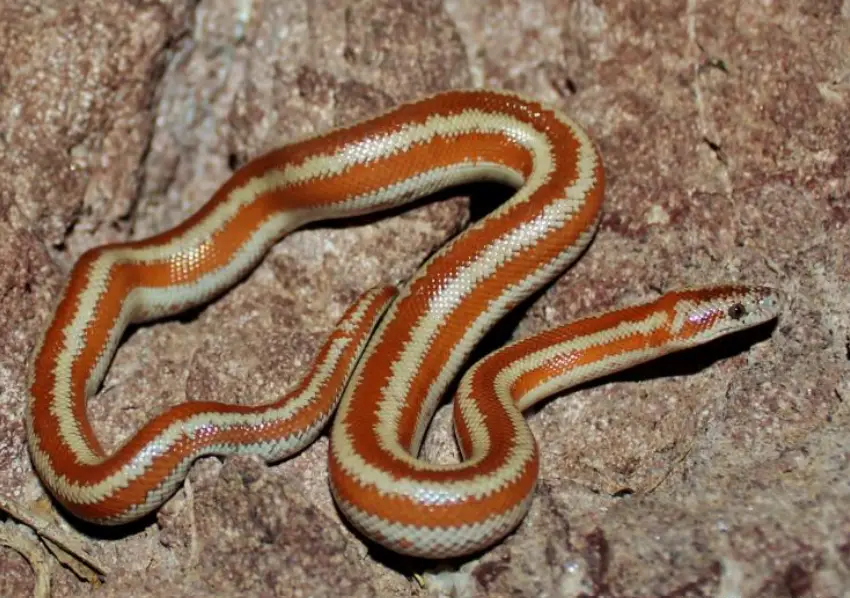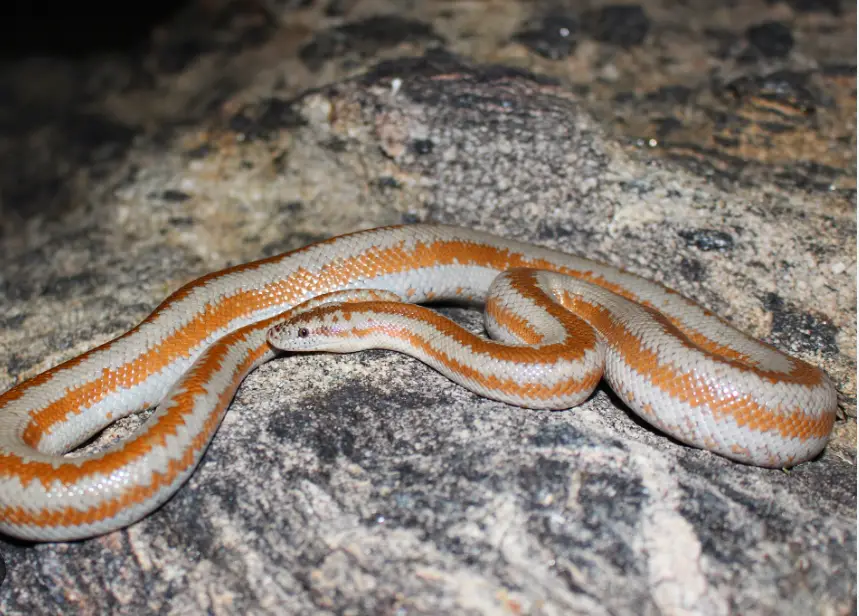Rosy boas are captivating snake species that have gained popularity among reptile enthusiasts. With their unique physical characteristics, calm temperament, and manageable size, they make an excellent choice for both beginner and experienced snake keepers. In this article, we will delve into the world of rosy boas, exploring their traits, habitat requirements, feeding habits, care tips, and more.
You may also want to read about albino pythons.
Overview of Rosy Boa
Physical Characteristics
Rosy boas are small to medium-sized snakes, typically measuring between 2 and 4 feet in length. They have a stout and muscular body with smooth scales. One of their distinguishing features is their vibrant coloration, which can range from shades of pink, orange, brown, and gray. The color patterns and intensity can vary among different subspecies and geographical regions.
Distribution and Habitat
Rosy boas are native to the southwestern United States and parts of Mexico. They inhabit a variety of terrains, including deserts, scrublands, and rocky areas. These snakes are primarily ground-dwellers but can also climb low vegetation or bask on rocks to regulate their body temperature.
Behavior and Temperament
Rosy boas are known for their docile and calm temperament, which makes them a popular choice for handling. They are generally slow-moving and rarely show aggression. However, it’s important to remember that individual behavior may vary, and proper handling techniques should always be followed to ensure the snake’s comfort and safety.
Housing and Enclosure
Tank Setup
When setting up a habitat for your rosy boa, a secure and appropriately sized enclosure is essential. A glass or plastic tank with a secure lid is recommended. The size of the enclosure should provide enough space for the snake to move around comfortably. A 20-gallon tank is suitable for juveniles, while adult rosy boas may require a 40-gallon tank or larger.
Substrate Options
Choosing the right substrate is crucial to create a comfortable and natural environment for your rosy boa. Aspen shavings, cypress mulch, or paper towels can serve as suitable substrate options. Avoid using substrates that can cause impaction or retain excessive moisture, such as sand or gravel.
Temperature and Humidity Requirements
Maintaining the proper temperature and humidity levels is vital for the health and well-being of your rosy boa. The ambient temperature in the enclosure should range between 75°F and 85°F (24°C to 29°C), with a basking spot reaching up to 90°F (32°C). A temperature gradient allows the snake to thermoregulate by moving between warmer and cooler areas. The humidity level should be around 50% to 60%, with a slight increase during shedding periods.
Feeding and Nutrition
Diet in the Wild
In their natural habitat, rosy boas primarily feed on small mammals, such as mice, rats, and occasionally lizards. Their hunting behavior involves ambushing their prey and constricting it until it becomes subdued.
Feeding Schedule for Captive Rosy Boas
In captivity, rosy boas should be fed appropriately sized prey items. Juveniles can be fed every 5 to 7 days, while adults can be fed every 10 to 14 days. It’s important to provide a varied diet, including frozen-thawed rodents to ensure proper nutrition.

Food Items and Prey Size
Prey items should be roughly the same size as the thickest part of the snake’s body. Pinky mice are suitable for juveniles, and as the snake grows, larger prey such as adult mice or small rats can be offered. Always monitor your snake during feeding to ensure it swallows the prey item properly.
Handling and Care
Gentle Handling Techniques
When handling your rosy boa, it’s crucial to approach the snake calmly and confidently. Support the snake’s body and avoid sudden movements that may startle or stress it. It’s recommended to wash your hands before and after handling to prevent any potential transfer of bacteria or parasites.
Regular Health Checkups
Routine health checkups by a qualified reptile veterinarian are essential to ensure your rosy boa’s well-being. Regular examinations can help detect any signs of illness or underlying health conditions early on. Additionally, ensure the enclosure is kept clean to prevent the growth of harmful bacteria.
Shedding and Skin Care
Like all snakes, rosy boas shed their skin periodically. Provide a humidity hide or a damp substrate during shedding to facilitate the process. Never forcefully remove the shed skin, as this can harm the snake. If you notice any difficulties during shedding, consult a reptile veterinarian for guidance.
Breeding and Reproduction
Mating Behavior
Rosy boas typically reach sexual maturity between 2 and 4 years of age. Breeding season usually occurs during the cooler months. Male rosy boas exhibit courtship behaviors, such as tongue flicking and following the female’s scent trail. Proper breeding setups with temperature fluctuations and separate mating enclosures may be necessary.
Gestation Period and Egg Laying
The gestation period for rosy boas is approximately 4 to 5 months. After mating, the female develops eggs internally, and live birth does not occur. Once ready to lay eggs, the female will seek a suitable spot in the enclosure to create a nest and lay her eggs.
Caring for the Hatchlings
Rosy boa hatchlings are born fully formed and independent. Provide them with a secure and appropriately sized enclosure, along with proper temperature and humidity conditions. Offer small, appropriately sized prey items, such as pinky mice, and monitor their growth and development closely.
Common Health Issues
Respiratory Infections
Respiratory infections can occur if the enclosure’s temperature and humidity levels are not maintained correctly. Symptoms may include wheezing, mucus discharge, and lethargy. If you suspect a respiratory infection, seek veterinary care promptly.
Parasites and External Issues
Parasites, such as mites or ticks, can affect rosy boas. Regularly inspect your snake for any signs of external parasites, such as small black dots or red mites. Treatment options are available, and a reptile veterinarian can guide you on appropriate treatment methods.
Shedding Problems
Difficulties during shedding, such as retained eye caps or incomplete shedding, can arise. Proper humidity levels and a shedding aid, like a humidity hide, can help facilitate the shedding process. If issues persist, consult a reptile veterinarian for assistance.
Conclusion
Rosy boas are captivating snake species with their unique coloration, calm temperament, and manageable size. By providing the right housing, appropriate diet, and gentle care, you can ensure a fulfilling and rewarding experience as a rosy boa owner. Remember to prioritize their health, engage in regular checkups, and provide a safe and enriched environment.
FAQs
- Can I house multiple rosy boas together?
- It’s generally not recommended to house multiple rosy boas together, as they are solitary animals and may exhibit aggression towards each other.
- Are rosy boas venomous?
- No, rosy boas are non-venomous snakes and pose no significant threat to humans.
- How long do rosy boas live?
- With proper care, rosy boas can live for 15 to 20 years or even longer.
- Can I handle my rosy boa during shedding?
- It’s best to avoid handling your rosy boa during shedding, as the process can be uncomfortable for the snake.
- Are rosy boas suitable for beginners?
- Yes, rosy boas are considered suitable for beginners due to their manageable size, calm temperament, and relatively straightforward care requirements.
